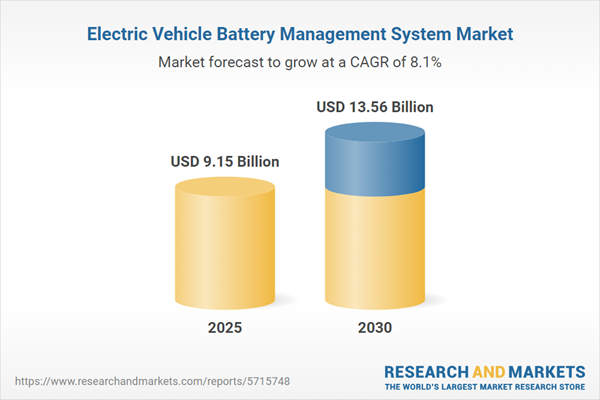Speak directly to the analyst to clarify any post sales queries you may have.
The electric vehicle battery management system market is undergoing substantial transformation, influenced by advances in hardware and software, evolving regulatory frameworks, and shifting supply chain dynamics. Senior decision-makers must grasp the current landscape to inform competitive strategy and capitalize on emerging opportunities.
Market Snapshot: Electric Vehicle Battery Management System Market Growth
The Electric Vehicle Battery Management System Market grew from USD 8.48 billion in 2024 to USD 9.15 billion in 2025. It is expected to continue growing at a CAGR of 8.14%, reaching USD 13.56 billion by 2030. This market demonstrates robust expansion as battery management systems become central to electric vehicle performance, reliability, and safety.
Scope & Segmentation
This report provides comprehensive analysis and forecasts across the following dimensions:
- Components: Hardware (Battery Control Units including Contactors & Relays, Microcontrollers; Battery Monitoring Units; Communication Channels; Power Management ICs; Sensors such as Current, Temperature, and Voltage), Software (Battery Management Software, Cloud-based Monitoring & Diagnostics)
- Topology: Centralized BMS, De-Centralized BMS, Modular BMS
- Voltage: High Voltage, Low Voltage, Medium Voltage
- Battery Type: Lead-Acid, Lithium-ion, Nickel-metal Hydride, Solid-State Batteries
- Cell Configuration: Cylindrical, Pouch, Prismatic Cell
- Charging Mode: Active Balancing, Fast Charging Support, Passive Balancing, Wireless Charging
- Cooling Method: Air Cooling, Immersion Cooling, Liquid Cooling, Refrigerant Direct Cooling
- Vehicle Type: Commercial Vehicles (Heavy: Buses, Trucks; Light), Off-Highway & Industrial (Agriculture: Harvesters, Tractors; Construction: Cranes, Excavators, Loaders), Passenger Cars (Hatchback, Sedan, SUV), Two-Wheelers (E-Motorcycles, E-Scooters)
- Regions: Americas (United States, Canada, Mexico, Brazil, Argentina, Chile, Colombia, Peru), Europe, Middle East & Africa (United Kingdom, Germany, France, Russia, Italy, Spain, Netherlands, Sweden, Poland, Switzerland, United Arab Emirates, Saudi Arabia, Qatar, Turkey, Israel, South Africa, Nigeria, Egypt, Kenya), Asia-Pacific (China, India, Japan, Australia, South Korea, Indonesia, Thailand, Malaysia, Singapore, Taiwan)
- Key Companies: Major players like Analog Devices, Inc., NXP Semiconductors N.V., Tesla, Inc., Renesas Electronics Corporation, Panasonic Corporation, Infineon Technologies AG, LG Energy Solution Ltd., and others are covered, providing insights into competitive strategies and recent developments.
Key Takeaways for Senior Decision-Makers
- Technological convergence is driving integration of advanced sensing, power management ICs, and analytics, elevating system sophistication for electric vehicles.
- Software-defined battery management, including machine learning and predictive diagnostics, is increasingly vital for optimizing energy efficiency and battery longevity.
- Regulatory change, especially heightened safety and sustainability standards, is prompting OEMs and suppliers to adopt new system architectures and compliance protocols.
- Regional dynamics and policy incentives are shaping market entry and adoption strategies, particularly as Asia-Pacific drives manufacturing scale, Europe emphasizes environmental targets, and the Americas lead in advanced diagnostics deployment.
- Emerging applications—such as electrified industrial vehicles, marine, and aerospace—necessitate scalable and modular solutions tailored to diverse operational profiles.
Tariff Impact on Supply Chain and Cost Structures
From 2025, United States tariff measures are directly reshaping procurement and production strategies within the battery management system market. Elevated duties on imported hardware components are encouraging manufacturers to reassess sourcing, prioritize domestic suppliers, and diversify across regions. Engineering teams are exploring localization of key subassemblies, while software licensing models evolve to address new cost realities. Strategic partnerships with regional providers and agile supply base diversification are emerging as critical tactics for risk mitigation and margin protection.
Methodology & Data Sources
This report uses a hybrid methodology combining primary interviews with industry experts and stakeholders, secondary research of technical documentation and regulatory materials, and systematic data triangulation. Findings are validated and cross-referenced to deliver reliable, actionable insights for executive strategy.
Why This Report Matters
- Enables informed decision-making for investments in advanced battery management technologies and strategic supplier alliances.
- Equips stakeholders with region-specific guidance for managing regulatory change and optimizing market entry.
- Delivers clarity on evolving technological, supply chain, and application trends critical to shaping the future of electric vehicle battery management systems.
Conclusion
The electric vehicle battery management system market is set to advance through technological innovation, regulatory adaptation, and strategic realignment of supply chains. Stakeholders positioned for agility and collaboration will capture the emerging value as the sector progresses.
Additional Product Information:
- Purchase of this report includes 1 year online access with quarterly updates.
- This report can be updated on request. Please contact our Customer Experience team using the Ask a Question widget on our website.
Table of Contents
3. Executive Summary
4. Market Overview
7. Cumulative Impact of Artificial Intelligence 2025
Companies Mentioned
The companies profiled in this Electric Vehicle Battery Management System market report include:- Analog Devices, Inc.
- Autosilicon Inc.
- AVL List GmbH
- BMS PowerSafe by Startec Energy Group
- DENSO Corporation
- Eberspächer Gruppe GmbH & Co. KG
- Evolito Ltd.
- Ewert Energy Systems, Inc.
- Hitachi, Ltd.
- Infineon Technologies AG
- Leclanché SA
- LG Energy Solution Ltd.
- LION Smart GmbH by LION E Mobility AG
- Marelli Holdings Co., Ltd.
- Mitsubishi Electric Corporation
- Navitas Systems LLC by East Penn Manufacturing Co.
- Nuvation Energy
- NXP Semiconductors N.V.
- Panasonic Corporation
- Renesas Electronics Corporation
- Robert Bosch GmbH
- Sensata Technologies, Inc.
- STMicroelectronics N.V.
- Tesla, Inc.
- Texas Instruments Incorporated
- Visteon Corporation
- Lithion Power Pvt. Ltd.
- SRM Technologies Private Ltd.
- AUTOVEN PRIVATE LIMITED
- Evolute Group
Table Information
| Report Attribute | Details |
|---|---|
| No. of Pages | 189 |
| Published | November 2025 |
| Forecast Period | 2025 - 2030 |
| Estimated Market Value ( USD | $ 9.15 Billion |
| Forecasted Market Value ( USD | $ 13.56 Billion |
| Compound Annual Growth Rate | 8.1% |
| Regions Covered | Global |
| No. of Companies Mentioned | 31 |









